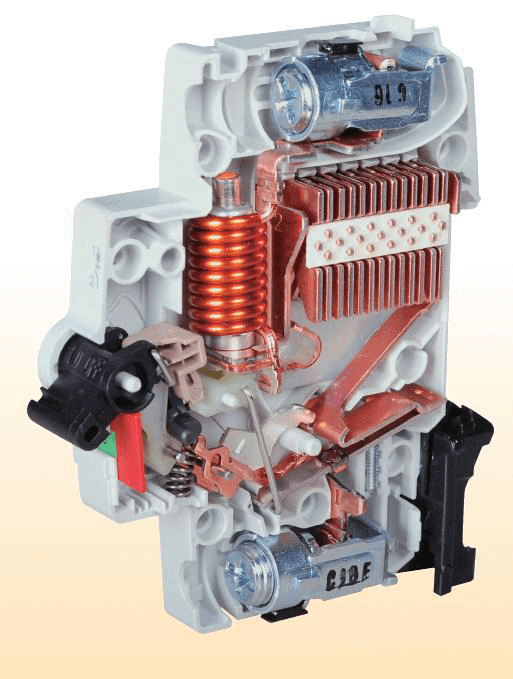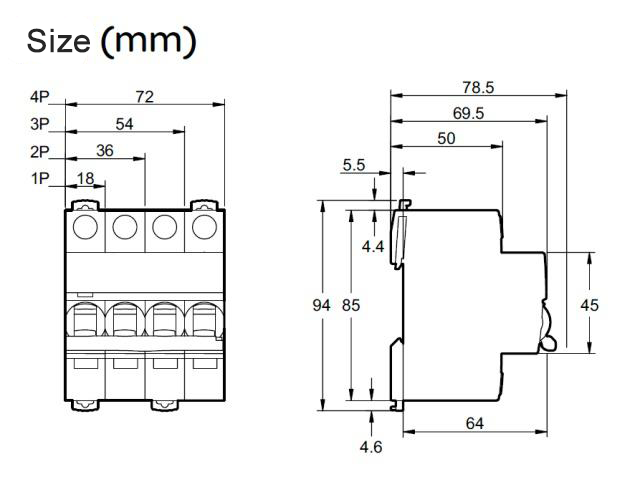dc circuit breaker
circuit breaker solar panel
miniature circuit breakers
Miniature circuit breakers, or Microbreakers for short, have been around us for more than a century, from generation to generation. Now they have evolved into the following kind of look.

Nader NDM1 Series
According to DC and AC two current kinds of system use, they can be divided into DC miniature circuit breakers and AC miniature circuit breakers. DC circuit breakers use more complex ARC extinguishing and current limiting systems than AC circuit breakers.

Mainstream MCB internal structure
The basic structure of Miniature circuit breakers includes Shell, in-out wiring junction, main contact point, electromagnetic coil, bimetal plate heat components, arc-extinguishing chamber, open-close switch mechanism, open-close switch status indication, installation mechanism, etc. .
Principe of Miniature Circuit Breaker Protection Circuit: current flow through the electromagnetic coil through the wiring junction point, then flow through the bimetal plate heat components and flow out through the following terminal junction point. When a short-circuit occurs in the circuit, a great current will pass through the electromagnetic coil in an instant. The iron core in the electromagnetic coil is driven by the electromagnetic force to break off the main contact point (short-circuit protection) of the open-close switch of the circuit breaker, the operation time is generally less than 0.01 second. When the current in the circuit is higher than the rated current value of the circuit breaker (overload) , the temperature of the bimetal plate will gradually increase due to the heat accumulation till the bimetal plate deforms and causes the breaker trip (overload protection) , the action time and the degree of overload have the relationship of inverse time limit, that is, the greater the overload current is, the shorter the trip time will be.
There are two key indexes for the selection of micro circuit breakers in the design of low-voltage complete products: the rated current In and the tripping curve. At the moment, the current ratings of micro circuit breakers are 1 / 2 / 3 / 4 / 6 / 10 / 16 / 20 / 25 / 32 / 40 / 50 / 63 / 80 / 100 / 125A and we reserve some allowance according to the circuit current.
Trip curve is the characteristic of the circuit breaker protection of the line, type C and type D are two common types. The instantaneous trip current of type C circuit breaker is about 5 ~ 10 times of the rated current, and that of type D is about 10 ~ 14 times of the rated current. For example: If a C10A micro-break is on the line and suddenly there appears a great 90A current, then the circuit breaker will probably appear a flash trip protection. If the installation is a D10A micro-break, the circuit breaker will not trip in the instant that a great 90A current is flowing into it. If the great 90A current lasts only for a few seconds and then returns to a steady current of a few Amperes, the circuit will continue to function normally. To sum up, in order to control the design and production costs, if the protection overload of the following terminals is a resistive load without great current such as a lamp, rice cooker or electric heater, then we can choose the c-type trip curve. If the load belongs to motor, electromagnet or transformer and is with great starting current, we should choose the d-type micro-break trip curve in order to ensure that the circuit breaker does not misoperate.
Sometimes we encounter situation where we only have the c-type micro-break in hands in the production or the field use process while the object being protected is the electric motor, at this point, we will also use the c-type instead of the d-type, but the premise is that the rated current should be a grade or two grades higher than the original d-type. That means a D10A circuit breaker with 140A-14 times of the rated current or a c-type with close to 140A-10 times of the rated current, so we have to choose a 16A C-type circuit breaker to replace the use.
As to the typical size of a miniature circuit breaker, 18 mm in width is a module (1 bit, 1p) , but the Schneider Electric is special. Schneider officially uses 9 mm as a module, friends in communication with Schneider customer service should pay attention to what they say in case of size design errors during box shell distribution. In fact, when we use it, it’s OK if we convert 9 and 18. There are two shell-frame current grades for micro-break, 63A and 125A. For the micro-break below 63A, 1 bit is 18 mm. For the micro-break of 125 shell-frame current, 1 bit is 27 mm.

Finally, I give you a small tip on the installation of micro-break. Micro-circuit breaker is installed in 35 mm standard guide rail.
If a circuit breaker in the distribution box needs to be replaced, and it happens to be sandwiched in between, then we can only remove the wire, pull the clamp at the bottom of the circuit breaker and let it separate with the guide rail.The clamp is not easy to pull by hand, and it is not easy to pry without a slotted screwdriver either, but we can remove the circuit breaker without using any tools.